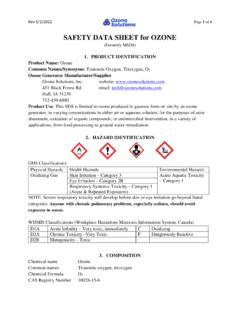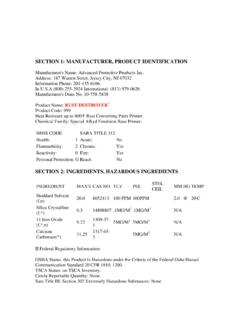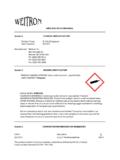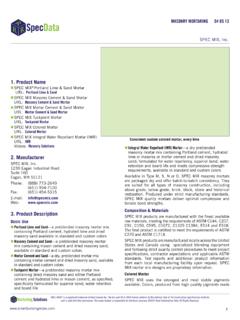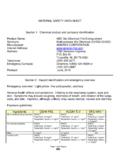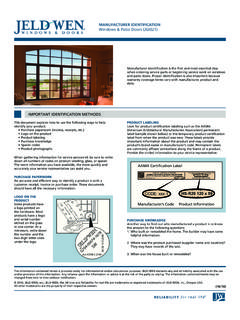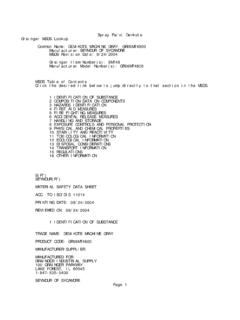Transcription of SAFETY DATA SHEET [formerly MSDS] 1 PRODUCT …
1 SAFETY data SHEET [ formerly msds ] Page 1 of 1 1. PRODUCT IDENTIFICATION PRODUCT name : OZONE Common Names/Synonyms: Triatomic Oxygen, Trioxygen, Ozone Generator Manufacturer/Supplier Ozone Solutions, Inc. 451 Black Forest Rd. Hull, IA 51239 712-439-6880 PRODUCT Use: This SDS is limited to ozone produced in gaseous form on site by an ozone generator, in varying concentrations, in either air or aqueous solution, for the purposes of odor abatement, oxidation of organic compounds, or antimicrobial intervention, in a variety of applications. 2. HAZARD IDENTIFICATION GHS Classifications: Physical Health: Environmental: Oxidizing Gas Skin Irritation Category 3 Eye Irritation Category 2B Respiratory System Toxicity Category 1 (Single & Repeated) Acute Aquatic Toxicity Category I NOTE: Severe respiratory toxicity will develop before skin or eye irritation go beyond listed categories.
2 Anyone with chronic pulmonary problems, especially asthma, should avoid exposure to ozone. WHMIS Classifications (Workplace Hazardous Materials Information System, Canada): C, D1A, D2A, D2B, F Source: CCOHS CHEMINFO Record Number 774 3. COMPOSITION Chemical name Ozone Common names Triatomic oxygen, trioxygen Chemical Formula O3 CAS Registry Number 10028-15-6 4. FIRST AID MEASURES Route of Entry Symptoms First Aid Skin Contact YES Irritation Rinse with water Skin Absorption NO NA NA Eye Contact YES Irritation Rinse with water, remove contacts Ingestion NO NA NA Inhalation YES Headache, cough, heavy chest, shortness of breath Remove to fresh air, provide oxygen therapy as needed For severe cases, or if symptoms don t improve, seek medical help.
3 5. FIRE FIGHTING MEASURES Ozone itself is not flammable. As a strong oxidant it may accelerate, even initiate, combustion, or cause explosions. Use whatever extinguishing agents are indicated for the burning materials. 6. ACCIDENTAL RELEASE MEASURES Turn off the ozone generator, and ventilate the area. Evacuate until ozone levels subside to a safe level (< ppm). 7. HANDLING AND STORAGE Ozone must be contained within ozone-resistant tubing and pipes from the generation point to the application point. 8. EXPOSURE CONTROLS/PERSONAL PROTECTION OSHA Permissible Exposure Limit: 8 hour TWA ppm ANSI/ASTM: 8 hour TWA ppm, STEL ppm ACGIH: 8 hour TWA ppm; STEL ppm NIOSH: ELCV ppm light; ppm moderate; ppm, heavy Light, moderate, heavy work TWA <= 2 hours: ppm Immediately Dangerous to Life or Health (IDLH) 5 ppm Respiratory Protection: Use full face self-contained breathing apparatus for entering areas with a high concentration of ozone.
4 Engineering control: Use ozone destruct unit for off gassing of ozone. 9. PHYSICAL AND CHEMICAL PROPERTIES Physical state Gas pH NA Molecular Weight Decomposition temperature NA Appearance Clear at low concentration, blue at higher concentration Evaporation rate NA Odor Distinct pungent odor Flash point NA Odor threshold to ppm; exposure desensitizes Auto-ignition temperature NA Melting point -193oC/-315oF Relative density NA Boiling point -112oC/-169oF Partition coefficient NA Vapor pressure > 1 atm Flammability NA Vapor density (air = 1) Explosive limits NA Solubility in water 570 mg/L @20oC @0oC Viscosity NA 10.
5 STABILITY AND REACTIVITY Ozone is highly unstable and highly reactive. Avoid contact with oxidizable substances. Ozone will readily react and spontaneously decompose under normal ambient temperatures. 11. TOXICOLOGICAL INFORMATION Likely routes of exposure: inhalation, eyes, skin exposure. Effects of Acute Exposure: Discomfort, including headache, coughing, dry throat, shortness of breath, pulmonary edema; higher levels of exposure intensify symptoms. Possible irritation of skin and/or eyes. Effects of Chronic Exposure: Similar to acute exposure effects, with possible development of chronic breathing disorders, including asthma.
6 LC50: mice, ppm for 3 hours; hamsters, ppm for 3 hours Irritancy of Ozone YES Sensitization to Ozone NO Carcinogenicity (NTP, IARC, OSHA) NO Reproductive Toxicity, Teratogenicity, Mutagenicity Not Proven Toxicologically Synergistic Products Increased susceptibility to allergens, pathogens, irritants 12. ECOLOGICAL INFORMATION The immediate surrounding area may be adversely affected by an ozone release, particularly plant life. Discharge of ozone in water solution may be harmful to aquatic life. Due to natural decomposition, bioaccumulation will not occur, and the area affected will be limited.
7 13. DISPOSAL CONSIDERATIONS Off-gassing of ozone should be through an ozone destruct unit which breaks ozone down to oxygen before release into the atmosphere. 14. TRANSPORT INFORMATION NOT APPLICABLE, as ozone is unstable and either reacts or decomposes, and must be generated at the location and time of use. 15. REGULATORY INFORMATION SARA Title III Section 302 EHS TPQ: 100 lbs. SARA Title III Section 304, EHS RQ: 100 lbs. SARA Title III Section 313: > 10,000 lbs. used/year. Source: EPA List of Lists 16. OTHER INFORMATION Half-life of ozone in water at 20oC = 20 min; in dry still air at 24oC = 25 hr; decreases significantly with increase in humidity, presence of contaminants, air movement, and/or increase in temperature.
8 Preparer: Tim McConnel, Ozone Solutions Date of Preparation: 5/1/2012 Disclaimer: Ozone Solutions provides this information in good faith, but makes no claim as to its comprehensiveness or accuracy. It is intended solely as a guide for the safe handling of the PRODUCT by properly trained personnel, and makes no representations or warranties, express or implied, of the merchantability or fitness of the PRODUCT for any purpose, and Ozone Solutions will not be responsible for any damages resulting from the use of, or reliance upon, this information.
